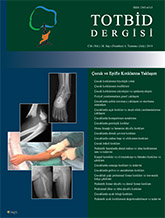
Foot fractures account for 5–14% of all pediatric fractures and approximately 7% of all physis injuries. The fact that foot fractures in children is less common than adults can be explained by the fact that cartilage has a more elastic structure than bone. Although most of the pediatric foot fractures are isolated injuries, some are associated with the polytrauma and serial examination of the entire skeletal system is required. A thorough understanding of the anatomy of the child foot is essential while treating these injuries. Since physical examination and radiological evaluation processes are more difficult in early and accurate diagnosis of a child with foot trauma, suspicious and cautious approach is very important. If compartment syndrome is suspected, compartment pressure measurements are very valuable. Computerized tomography imaging may be required in addition to plain radiographs to determine the fracture pattern and to plan the treatment. Although pediatric foot fractures usually have good results with conservative treatment, some of these fractures may have poor results despite anatomic reduction and internal fixation. The treatment of pediatric foot fractures usually results in good outcomes, but the possible poor outcomes of the fractures of the Lisfranc, talus neck, and talus body fractures should be avoided as much as possible.